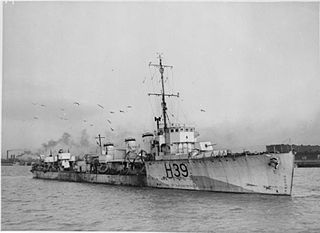
HMS Egret was a sloop of the British Royal Navy, the lead ship of her class. She was built by J. Samuel White at Cowes, Isle of Wight, was launched on 31 May 1938, and entered service on 11 November that year. Egret served as a convoy escort with the Western Approaches Command from 1940 until her loss in August 1943: She was on anti-submarine patrol in the Bay of Biscay when she was sunk by a guided missile in combat, the first ship to be lost in this manner.
HMS Gladiolus was a Flower-class corvette of the Royal Navy, the first ship of her class.
ONS 5 was the 5th of the numbered ONS series of Slow trade convoys Outbound from the British Isles to North America. The North Atlantic battle surrounding it in May 1943 is regarded as the turning point of the Battle of the Atlantic in World War II. The battle ebbed and flowed over a period of a week, and involved more than 50 Allied ships and their escorts, and over 30 U-boats. It saw heavy losses on both sides. However it was almost the last Allied convoy to do so, while losses inflicted on attacking U-boats and U-boat groups became a besetting feature of the campaign; As such it is seen as the point when the tactical and strategic advantage passed to the Allies, and ushered in the period known to Nazi Germany's Kriegsmarine as Black May.

Convoy SC 130 was a North Atlantic convoy which ran during the battle of the Atlantic in World War II. It was the 130th of the numbered series of Slow Convoys of merchant ships from Sydney, Cape Breton Island to Liverpool. SC 130 was one of several convoy battles that occurred during the crisis month of May 1943.

HG 76 was an Allied convoy of the HG series, during the Second World War. It was notable for the destruction of five German U-boats.
ONS 18 and ON 202 were North Atlantic convoys of the ONS/ON series which ran during the battle of the Atlantic in World War II. They were the subject of a major U-boat attack in September 1943, the first battle in the Kriegsmarine's autumn offensive, following the withdrawal from the North Atlantic route after Black May.
SC 143 was a North Atlantic convoy of the SC series which ran during the battle of the Atlantic in World War II. It was the second battle in the Kriegsmarine's autumn offensive in the North Atlantic.
ONS 20 and ON 206 were North Atlantic convoys of the ONS/ON series which ran during the battle of the Atlantic in World War II. They were the subject of a major U-boat attack in October 1943, the third battle in the Kriegsmarine's autumn offensive.
Siegfried was a "wolfpack" of German U-boats that operated during the battle of the Atlantic in World War II.
SC 48 was a North Atlantic convoy of the SC series which ran during the battle of the Atlantic in World War II.
Escort Group B7 was a British formation of the Royal Navy which saw action during the Second World War; principally in the Battle of the Atlantic.
36th Escort Group was a British formation of the Royal Navy which saw action during the Second World War, principally in the Battle of the Atlantic. The group operated mainly on the Gibraltar and South Atlantic convoy routes and was involved in several convoy battles, including Convoy HG 76, one of the first Allied victories in the Atlantic campaign.

An Escort Group consisted of several small warships organized and trained to operate together protecting trade convoys. Escort groups were a World War II tactical innovation in anti-submarine warfare by the Royal Navy to combat the threat of the Kriegsmarine's "wolfpack" tactics. Early escort groups often contained destroyers, sloops, naval trawlers and, later, corvettes of differing specifications lacking the ability to maneuver together as a flotilla of similar warships, but rigorously trained in anti-submarine tactics to use teamwork emphasizing the unique sensors, weapons, speed, and turning radius of each ship. The development of these 'escort groups' proved an effective means of defending shipping convoys through the Battle of the Atlantic.
Convoys SL 139/MKS 30 were two Allied convoys which ran during the Battle of the Atlantic in World War II. SL 139 was one of the SL convoys from the South Atlantic to Britain, and MKS 30 one of the MKS convoys between Britain and the Mediterranean. They were sailing together on the Gibraltar homeward route, having made a rendezvous off Gibraltar in November 1943. They were the subject of a major U-boat attack, as part of the Kriegsmarine's renewed Autumn offensive.
Convoys SL 140/MKS 31 were two Allied convoys which ran during the Battle of the Atlantic in World War II. SL 140 was one of the SL convoys from the South Atlantic to Britain, and MKS 31 was one of the MKS convoys between Britain and the Mediterranean.
Borkum was a wolf pack of German U-boats that operated during the battle of the Atlantic in World War II.
SC 2 was an Allied North Atlantic convoy of the SC series which ran during the Battle of the Atlantic in World War II. It was attacked by a wolfpack of German U-boats, losing five merchant ships.

HMS Vetch (K132) was a Flower-class corvette that served in the Royal Navy during the Second World War. After helping to escort many convoys and sinking two U-boats, she was decommissioned and sold in 1945.

HMS Stork (L81) was a Bittern-class sloop of the Royal Navy. She was active during the Second World War, serving in convoy escort groups, and was a successful anti-submarine warfare vessel, being credited with the destruction of four U-boats.

HMS Rochester (L50) was a Shoreham-class sloop of the Royal Navy. She served during the Second World War and was a successful anti-submarine warfare vessel, being credited with the destruction of five U-boats.






